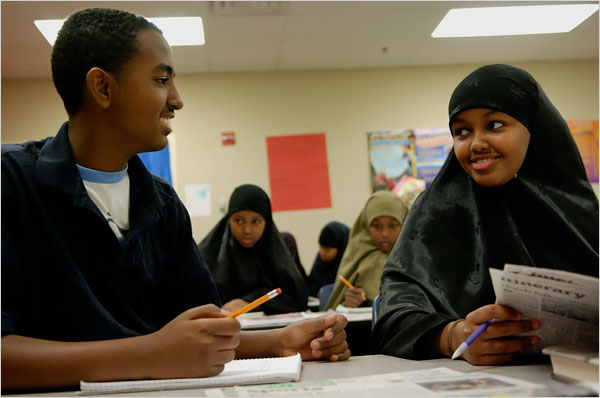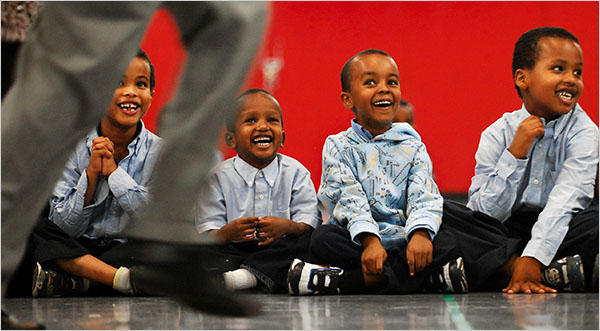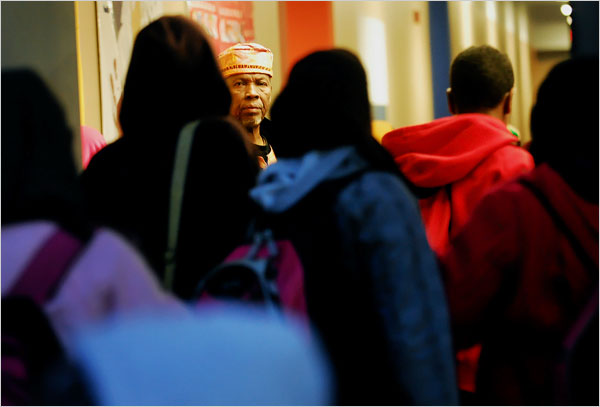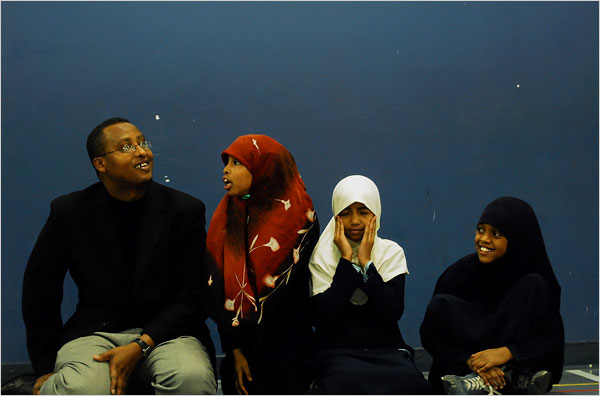|
Immigrants See
Charter Schools as a Haven
(Minneapolis, January,
10 2009 Ceegaag Online)

Fartun Warsame, a Somali immigrant, thought she was being
a good mother when she transferred her five boys to a top
elementary school in an affluent Minneapolis suburb. Besides
its academic advantages, the school was close to her job as
an ultrasound technician, so if the teachers called, she
could get there right away.
“Immediately they changed,” Ms. Warsame said of her sons.
“They wanted to wear shorts. They’d say, ‘Buy me this.’ I
said, ‘Where did you guys get this idea you can control
me?’ ”
Her sons informed her that this was the way things were
in America. But not in this Somali mother’s house. She soon
moved them back to the city, to the International Elementary
School, a charter school of about 560 pupils in downtown
Minneapolis founded by leaders of the city’s large East
African community. The extra commuting time was worth the
return to the old order: five well-behaved sons, and one
all-powerful mother.
Charter schools, which are publicly financed but
independently run, were conceived as a way to improve
academic performance. But for immigrant families, they have
also become havens where their children are shielded from
the American youth culture that pervades large district
schools.

The curriculum at the Twin Cities
International Elementary School, and at its partner middle
school and high school, is similar to that of other public
schools with high academic goals. But at Twin Cities
International the girls say they can freely wear head
scarves without being teased, the lunchroom serves food that
meets the dietary requirements of Muslims, and in every
classroom there are East African teaching assistants who
understand the needs of students who may have spent years in
refugee camps. Twin Cities International students are from
Ethiopia, Kenya, Somalia and Sudan, with a small population
from the Middle East.
Amid the wave of immigration that has been reshaping
Minnesota for more than three decades, the International
schools are among 30 of the state’s 138 charter schools that
are focused mostly on students from specific immigrant or
ethnic groups. To visit a half-dozen of these schools, to
listen to teachers, administrators and parents — Somali
immigrants who are relatively new to Minnesota, as well as
the Hmong and Latinos who have been in the state for decades
— is to understand that Ms. Warsame’s high educational
aspirations for her children, and her fears, are universal.
“The good news is that immigrant kids are learning
English better and faster than ever before in U.S. history,”
said Marcelo M. Suárez-Orozco, the co-director of
immigration studies at New York University and co-author of
“Learning a New Land — Immigrant Students in American
Society” (Harvard Press, 2008). “But they’re assimilating to
a society that parents see as very threatening and
frightening. It’s anti-authority, anti-studying. It’s
materialistic.”
Some critics argue that these kinds
of charter schools are contributing to a growing
re-segregation of public education, and that they run
counter to the long-held idea of public schools as the
primary institution of the so-called “melting pot,” the
engine that forges a common American identity among
immigrants from many countries.
 
“One of the primary reasons that American society
supports public schools is to give everyone a solid civic
education,” said Diane Ravitch, an education historian, “the
sort of education that comes from learning together with
others from different backgrounds.”
But Dr. Suárez-Orozco says the reality is that most new
immigrants become isolated in public schools, and that large
numbers of them become alienated over time and fail to
graduate.
A place like Minnesota, with its strong charter-school
movement, offers immigrant parents, who have long been
conflicted about their children becoming Americanized, a
strong voice in their children’s education, Dr. Suárez-Orozco
said, and shows their eagerness to participate in democracy.
“What the parents are saying,” he said, “is, We want our
children to assimilate, we want them to acculturate, but we
want to be proactively engaged in shaping that process.”
Ali Somo, a 70-year-old father of three children at the
International Schools, put it this way: “We bring our
children here because we want them close to us so they don’t
get lost.”
It was a weekday morning, but Mr.
Somo and Ms. Warsame and a group of other parents, some
holding down double shifts as cabdrivers, hotel
housekeepers, and parking lot attendants, were squeezing in
a meeting in the school library, with its shelves lined with
“Huckleberry Finn,” “The Red Badge of Courage,” “Little
House on the Prairie” and other American classics.
 
Getting lost in America, Mr. Somo explained, means losing
your culture, your language, your identity. It means acting
like the teenagers the parents see on the street — wearing
baggy jeans, smoking, using drugs, disrespecting elders.
“I have been in America, and I have observed,” Mr. Somo
testified. “I have seen children with their pants falling
off. I have seen them doing drugs.”
The parents around him nodded. Another father, Jelil
Abdella, talked about how it saddened him that his two grown
children, who had attended large district schools, did not
know how to speak Somali. “They’re neither American, nor
Somali,” Mr. Abdella said.
As a newcomer, he said, he was too busy going to school
and earning a living — driving a taxi, cleaning floors,
working in a factory, picking blueberries — to supervise
their educations closely.
“I don’t want to make the same mistake with my younger
children,” he said. “I want them to keep the good things we
used to have back home — respecting their parents, helping
each other, respecting their elders.”
Another father, Mahamaud Wardere,
said: “It is important that they all know they’re American.
It is equally important that they know they’re Somali.”
It is this dual identity that the International Schools
work to encourage. There are lessons in snowshoeing and
baseball, and field trips to the Mall of America, where
instead of shopping, the students participate in another
American ritual, the charity fund-raising walk. There are
also teen-agers complaining that their parents worry too
much.
“I can at least account for more than 200 lectures I’ve
had from my mom and dad about American culture here,” said
Omar Ahmed, a 14-year-old eighth grader. “My dad always
says, ‘Back in Somalia, when I was 14, I could see myself
running my own business, having my own children. You’re 14,
you can’t get your studies done.’ ”
“Every time my mom sees something bad about teens in the
news,” Omar said, “there’s another lecture on that subject.”
Perhaps nothing more vividly demonstrated the students’
enthusiasm for American democracy than a debate this fall in
Elizabeth Veldman’s eighth-grade social studies class about
the presidential race. The two teams of students had spent
days preparing.
“Look at our history — look at what
happened with the Vietnam War,” said Yaqub Ali, 13, a
fervent supporter of Senator John McCain who arrived four
years ago from a Somalian refugee camp in Kenya, knowing no
English. “Do you want to lose a war?”
“Sit down, Yaqub!” commanded Ridwa Yakob, who describes
herself as “a girl who loves to talk.” She argued that
Senator Barack Obama would fix everything from education to
the economy.
Yaqub, wearing a dark suit for the occasion, rose again.
“John McCain is old,” he said. “It is better to be old.”
At the International school, where elders are revered,
even Ridwa was silenced.
At their meeting, the parents talked of the importance of
speaking English at school — and Somali or Oromo at home. At
other charter schools, Hmong refugee and Latino parents
expressed the same wish, the difference being that they want
their children to speak Hmong, or Spanish, at home, the
other difference being that many of their children are
already so Americanized that they are learning their
parents’ languages in school.
“The other day a spider fell from the roof and my son
picked it up,” Mr. Somo said, referring to his 13-year-old,
Hussein. “What do you call it in English, I asked him. He
told me. How to say it in Oromo — I told him myself. How to
say it in Arabic and Somali — he learned it himself. He was
able to say the word for “spider” in four languages.”
With that kind of linguistic talent, Mr. Somo said of his
son, “he can work for America anywhere in the world.”
Dr. Suárez-Orozco said: “What these parents are doing, in
taking ownership of their children’s schools, is as American
as apple pie. They’re doing what soccer moms and dads in
Lexington, Mass., and Concord and Cambridge do day in and
day out. They’re modeling for kids the story of
acculturation and how it works.”
Source: AP

webmaster@ceegaag.com |

